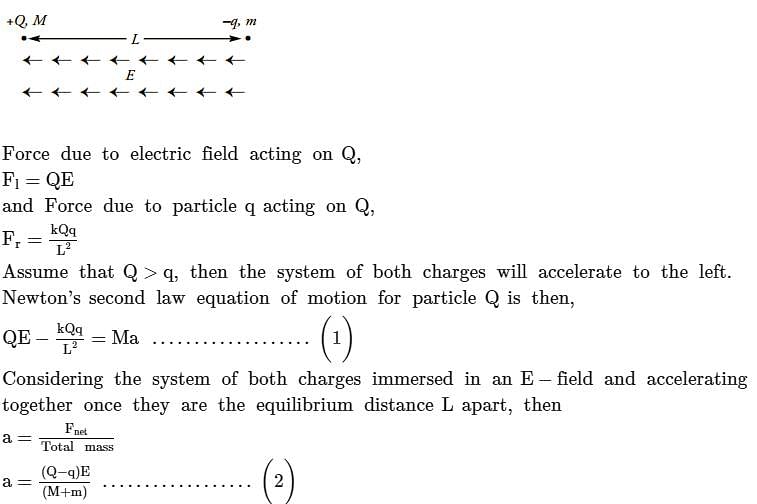JEE Exam > JEE Questions > Two charged particles (M,+Q) and (m,-q) are p...
Start Learning for Free
Two charged particles (M,+Q) and (m,-q) are placed in a uniform electric field .After the particles are released ,they stay at a constant distance from each other .what is this distance(L)?Neglect Gravitational interaction.?
Verified Answer
Two charged particles (M,+Q) and (m,-q) are placed in a uniform electr...
Ans.




 This question is part of UPSC exam. View all JEE courses
This question is part of UPSC exam. View all JEE courses
Most Upvoted Answer
Two charged particles (M,+Q) and (m,-q) are placed in a uniform electr...
Introduction:
In this problem, we have two charged particles labeled as M and m. Particle M has charge Q, while particle m has charge -q. These particles are placed in a uniform electric field and are released. After the release, the particles stay at a constant distance from each other. We need to determine this distance, denoted as L, neglecting the gravitational interaction between the particles.
Explanation:
To solve this problem, we need to consider the forces acting on the charged particles and find the equilibrium condition where the net force on each particle is zero.
1. Electric Force:
The electric force between two charged particles is given by Coulomb's Law:
F = k * |Q * q| / r^2
where F is the electric force, Q and q are the charges on the particles, r is the distance between them, and k is the electrostatic constant.
2. Net Force:
Since the particles stay at a constant distance from each other, the net force on each particle must be zero. Therefore, the electric forces acting on the particles must be equal in magnitude and opposite in direction.
3. Equation:
Using the above conditions, we can write the equation for the electric forces as:
k * |Q * q| / L^2 = k * |Q * q| / L^2
where L is the distance between the particles.
4. Simplification:
We can cancel out the common terms and simplify the equation to:
L^2 = L^2
5. Solution:
From the equation, we can see that the distance between the particles, L, is the same on both sides. Therefore, the distance between the particles remains constant, and we can't determine its value from the given information.
Conclusion:
In conclusion, the distance (L) between the charged particles (M, Q) and (m, -q) remains constant in a uniform electric field. However, without additional information, we cannot determine the exact value of this distance. This analysis is based on the assumption that the gravitational interaction between the particles is negligible.
In this problem, we have two charged particles labeled as M and m. Particle M has charge Q, while particle m has charge -q. These particles are placed in a uniform electric field and are released. After the release, the particles stay at a constant distance from each other. We need to determine this distance, denoted as L, neglecting the gravitational interaction between the particles.
Explanation:
To solve this problem, we need to consider the forces acting on the charged particles and find the equilibrium condition where the net force on each particle is zero.
1. Electric Force:
The electric force between two charged particles is given by Coulomb's Law:
F = k * |Q * q| / r^2
where F is the electric force, Q and q are the charges on the particles, r is the distance between them, and k is the electrostatic constant.
2. Net Force:
Since the particles stay at a constant distance from each other, the net force on each particle must be zero. Therefore, the electric forces acting on the particles must be equal in magnitude and opposite in direction.
3. Equation:
Using the above conditions, we can write the equation for the electric forces as:
k * |Q * q| / L^2 = k * |Q * q| / L^2
where L is the distance between the particles.
4. Simplification:
We can cancel out the common terms and simplify the equation to:
L^2 = L^2
5. Solution:
From the equation, we can see that the distance between the particles, L, is the same on both sides. Therefore, the distance between the particles remains constant, and we can't determine its value from the given information.
Conclusion:
In conclusion, the distance (L) between the charged particles (M, Q) and (m, -q) remains constant in a uniform electric field. However, without additional information, we cannot determine the exact value of this distance. This analysis is based on the assumption that the gravitational interaction between the particles is negligible.
Attention JEE Students!
To make sure you are not studying endlessly, EduRev has designed JEE study material, with Structured Courses, Videos, & Test Series. Plus get personalized analysis, doubt solving and improvement plans to achieve a great score in JEE.

|
Explore Courses for JEE exam
|

|
Similar JEE Doubts
Two charged particles (M,+Q) and (m,-q) are placed in a uniform electric field .After the particles are released ,they stay at a constant distance from each other .what is this distance(L)?Neglect Gravitational interaction.?
Question Description
Two charged particles (M,+Q) and (m,-q) are placed in a uniform electric field .After the particles are released ,they stay at a constant distance from each other .what is this distance(L)?Neglect Gravitational interaction.? for JEE 2024 is part of JEE preparation. The Question and answers have been prepared according to the JEE exam syllabus. Information about Two charged particles (M,+Q) and (m,-q) are placed in a uniform electric field .After the particles are released ,they stay at a constant distance from each other .what is this distance(L)?Neglect Gravitational interaction.? covers all topics & solutions for JEE 2024 Exam. Find important definitions, questions, meanings, examples, exercises and tests below for Two charged particles (M,+Q) and (m,-q) are placed in a uniform electric field .After the particles are released ,they stay at a constant distance from each other .what is this distance(L)?Neglect Gravitational interaction.?.
Two charged particles (M,+Q) and (m,-q) are placed in a uniform electric field .After the particles are released ,they stay at a constant distance from each other .what is this distance(L)?Neglect Gravitational interaction.? for JEE 2024 is part of JEE preparation. The Question and answers have been prepared according to the JEE exam syllabus. Information about Two charged particles (M,+Q) and (m,-q) are placed in a uniform electric field .After the particles are released ,they stay at a constant distance from each other .what is this distance(L)?Neglect Gravitational interaction.? covers all topics & solutions for JEE 2024 Exam. Find important definitions, questions, meanings, examples, exercises and tests below for Two charged particles (M,+Q) and (m,-q) are placed in a uniform electric field .After the particles are released ,they stay at a constant distance from each other .what is this distance(L)?Neglect Gravitational interaction.?.
Solutions for Two charged particles (M,+Q) and (m,-q) are placed in a uniform electric field .After the particles are released ,they stay at a constant distance from each other .what is this distance(L)?Neglect Gravitational interaction.? in English & in Hindi are available as part of our courses for JEE.
Download more important topics, notes, lectures and mock test series for JEE Exam by signing up for free.
Here you can find the meaning of Two charged particles (M,+Q) and (m,-q) are placed in a uniform electric field .After the particles are released ,they stay at a constant distance from each other .what is this distance(L)?Neglect Gravitational interaction.? defined & explained in the simplest way possible. Besides giving the explanation of
Two charged particles (M,+Q) and (m,-q) are placed in a uniform electric field .After the particles are released ,they stay at a constant distance from each other .what is this distance(L)?Neglect Gravitational interaction.?, a detailed solution for Two charged particles (M,+Q) and (m,-q) are placed in a uniform electric field .After the particles are released ,they stay at a constant distance from each other .what is this distance(L)?Neglect Gravitational interaction.? has been provided alongside types of Two charged particles (M,+Q) and (m,-q) are placed in a uniform electric field .After the particles are released ,they stay at a constant distance from each other .what is this distance(L)?Neglect Gravitational interaction.? theory, EduRev gives you an
ample number of questions to practice Two charged particles (M,+Q) and (m,-q) are placed in a uniform electric field .After the particles are released ,they stay at a constant distance from each other .what is this distance(L)?Neglect Gravitational interaction.? tests, examples and also practice JEE tests.

|
Explore Courses for JEE exam
|

|
Suggested Free Tests
Signup for Free!
Signup to see your scores go up within 7 days! Learn & Practice with 1000+ FREE Notes, Videos & Tests.

























